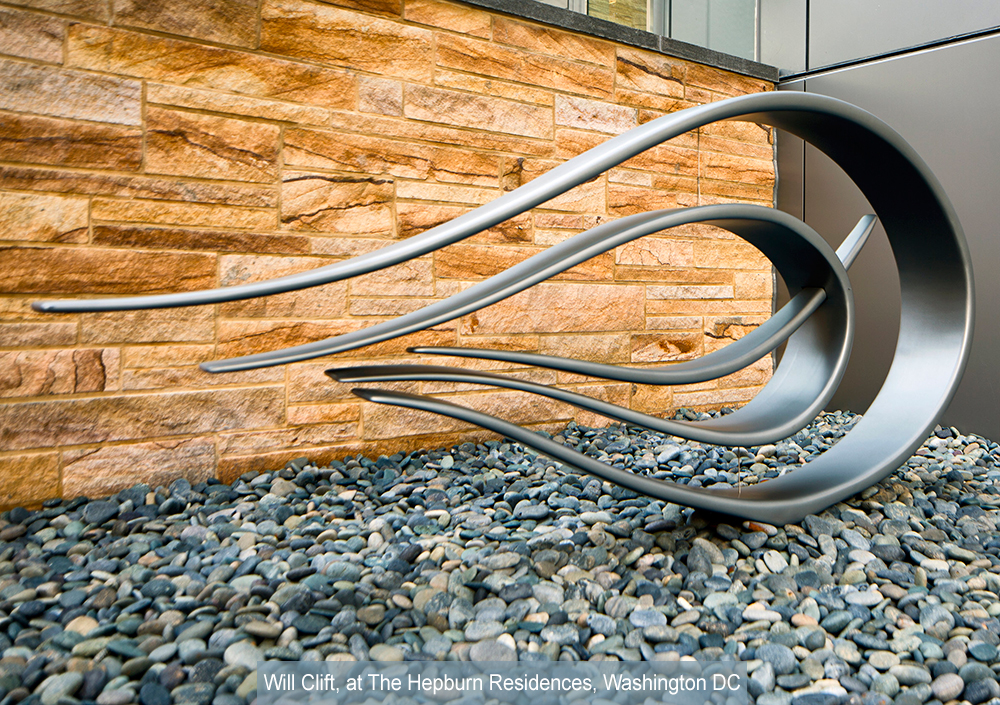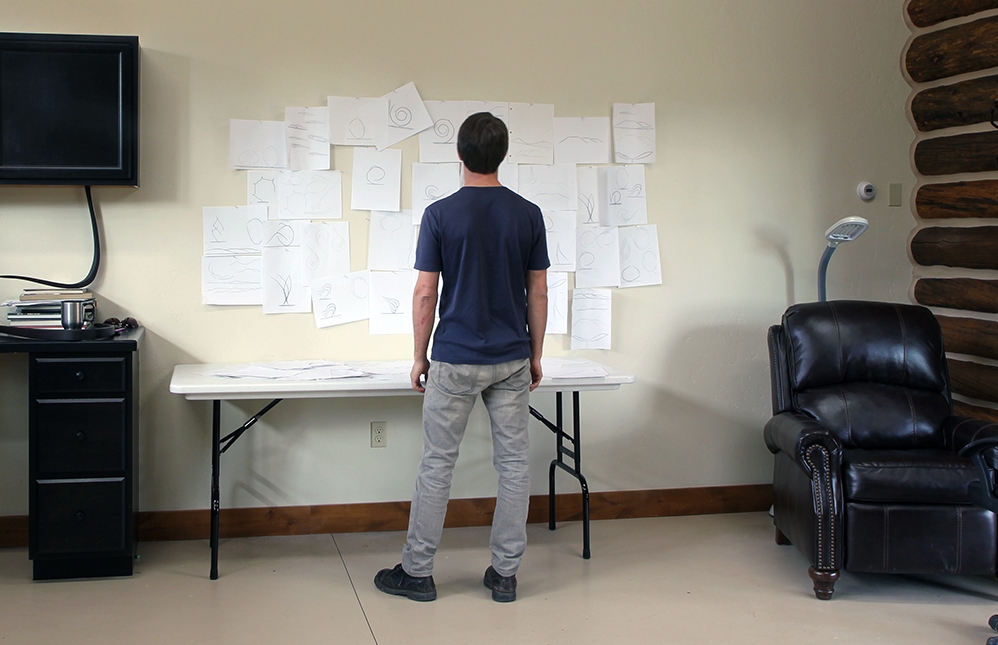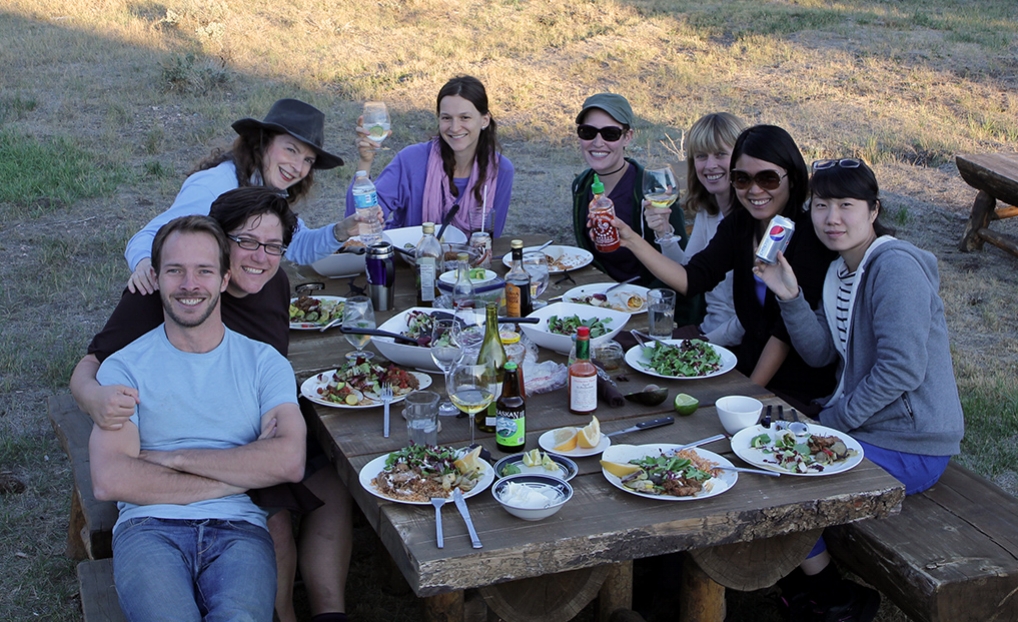Featured Artist/Traveler - Will Clift
Will installing “Nested” in front of the Baptist MD Anderson Cancer Center in Jacksonville, FL 2018
Will Clift’s sculptures are like graceful 3D drawings, defying gravity, and swooping and soaring upward and outward. In his words they “explore the line between order and chaos, combining intersecting parts into a whole that stands in delicate equilibrium on a small foot. Each work is inherently precarious, yet ultimately poised and stable, overcoming entropy…there is grace when the point of balance is reached."
Will is based in Santa Fe, NM, and has traveled with his work around the globe - exhibiting in Hong Kong, Shanghai, Taipei, Australia and Mexico. He has also been an artist in residence in Spain, Ireland, France and Wyoming. He is represented by Galerie Ora-Ora in Hong Kong, and Gerald Peters Gallery in Santa Fe and New York City.
Will working as an artist-in-residence at La Napoule in the south of France.
Hello Will, thanks for sharing your art/travel story with us! We met some years ago when you were living in Boulder, and we discovered we had been to several of the same artist residencies - 2 of them in Spain. It was fun to compare some very dramatic stories!
To start with, let’s hear a bit about your background. I understand you never studied art - instead you followed various paths such as engineering and psychology in college. What changed for you that made you become a full time artist?
I grew up with an artist father (he’s a black and white photographer). He’s been quite successful as an artist, supporting a family of five, but I saw first-hand how uncertain that life is, and how stressful it can be to never know when money would come in. So I always thought I wanted a job with a salary, something secure. I also always liked building things, so I gravitated towards engineering and other fields. After finishing grad school, I worked as an engineering and architecture consultant for three years, which is what brought me to Colorado.
But after those three years, I realized that I would never feel whole doing a job like that. I had kept going with my sculpture work all through college, and to make a long story short, at some point I decided to quit the day job; I gave myself six months… six months to make a go of it without looking for another job. I was very, very lucky that it worked out for me. A thousand things could have been different and that might not have been the case. The anniversaries of leaving that job and becoming a full-time sculptor (almost 13 years ago, now!) tend to be more meaningful than my birthdays!
I love that your yearly commitment to your art is a more fulfilling measure of your time than simply the years themselves!
About your work, can you explain how you came to your distinctive style of sculpture and how it has evolved over the years? What materials do you use?
It’s all about the balance.
I have worked with wood ever since I was a kid — first towers out of wooden blocks, then animals that I’d cut out on a scroll saw, which my parents bought for me when I was about 6. This evolved into making furniture when I was a teenager.
Then in my last year of high school, my physics teacher asked the class to “find or make something that balances but looks like it shouldn’t.” The next morning — of course I had forgotten all about it — so I rummaged through my box of furniture wood scraps, pulled some pieces out, chiseled a couple of rough holes, and connected them into a self-supporting structure that stood on a small foot. That was the seed out of which my current work grew.
Now I still work some in wood, but as my work has grown larger and I’ve begun making outdoor sculptures, I’ve learned to work with other materials. I’ve learned to love each of them for their own qualities — steel, on rare occasions bronze, composite materials, and even concrete.
As a professional artist - how do you juggle family, money and travel? And do you support yourself completely with selling your art or do you teach or have other means of income?
Well, it helps to have a trust fund and a wealthy spouse (of course, I don’t have either). I think any artist who tells you their success is all due to talent is full of it. Luck and hard work are HUGE components of what has let me make it work to this point.
I’ve never taught, mostly because I didn’t go to art school myself, and I’ve never known what I would have to offer. That’s slowly changing, but if I’m going to teach at some point, there'll have to be a clear reason for it, rather than just as a way to pay a bill.
So, making things work financially is about working hard, diversifying income, and reducing costs. I’ve always tried to be strategic about it, finding different markets for my work, and picking the right partners (agents, galleries, etc). Keeping overhead low is important, too. Do I really need a big sexy warehouse in Brooklyn or LA for a studio? Then knowing that there will be tough times and saving money for them — that’s been critical for me. 2009, 2010… those years almost broke me, but I had put away enough before then that I could pay my student loans and also live. That downturn was before I had a wife, kids, or a mortgage, so that was just fortunate timing…
Working along the Mediterranean at La Napoule Residency in the south of France.
How does travel fit in to this picture? When were you first called to travel, and how did your art life fit in with that?
Travel is huge for me, and always has been. It wasn’t a big part of life when I was a kid, though… I barely went abroad until I managed to talk my way into a trip to Russia being organized by a local group. That was right after the fall of the Soviet Union — I think I was 13 — and that was my first trip without my parents. But it snowballed from there. In college I decided to study Japanese instead of continue with French, and I spent six months in Japan my Junior year, which definitely changed my life.
Then whenever I had a bit of money and time, I’d go somewhere. Chile, Argentina, Mexico, Myanmar, all over Europe, and of course all over the US. For me I need to be on the road, away from the familiar (and, often, away from comfort) to develop the earliest concepts for new works. Fortunately, as my career has evolved, opportunities to travel come to me more often. I show with a gallery in Hong Kong which has brought me out there for a couple of shows, plus to Shanghai for an art fair there. And then prizes and commissions have taken me to places like Australia and Taiwan, plus all over the US.
Then residencies, of course, are a whole other topic… those are still just about my favorite way to be in a foreign country if my aim is to generate new work.
Studying his sketches at Brush Creek Foundation for the Arts, WY 2013
How did you first hear about artist residencies, and why did you choose the ones you eventually attended?
At this point I can’t remember where I first heard of residencies. I prefer group residencies, where everyone is doing a different type of artistic practice, because I get a lot out of those times with other artists. Everyone creates in different ways, and for different reasons, and being exposed to those other approaches can open oneself up, help get past creative blockages, and even lead to collaborations.
That said, if you happen into a residency with a group that doesn’t quite gel, it can be awkward. There have been a couple like that. There have been others that have felt like a reality TV show, with romantic drama, competitiveness, near-mental-breakdowns, etc. Neither of those types are particularly conducive to good work, though of course one never knows what one will get.
What kind of project proposals have you applied to residencies with?
I always propose a concrete project of some type. More often than not, I’ll spend at least some of the time working on it, but sometimes I get there and get totally sidetracked. Without exception, the hosts have been happy to let me follow what pulls me in, which is just how it should be.
Will with his sketches in process at Cowhouse Artist Residency in Ireland 2018.
How does the PLACE impact the work that you do? Or do you bring your ideas with you and develop them further regardless of where you are?
Both. I tend to pick residencies in rural places, because nature inspires me, and the quiet really helps me to develop ideas. But cities also give me a certain food, perhaps planting the earliest seeds of future work, which I then need to refine later, in a quieter place.
I know you have a family with young kids, are you still able to travel much at this stage of your life, and if so, how?
It’s definitely harder. I have a three-and-a-half year old and a five-month old, and now instead of spending a week on either side of an opening in NYC, I’m taking red-eyes and cutting the time on the ground down to the absolute minimum of a couple of days. I’m enormously lucky, though, that my wife has a flexible job, that she needs to travel for work, and that she enjoys travel as much as I do.
A couple of years ago we were both in discussions with Stanford University about taking parts in different programs. We somehow made it work for me to get an appointment as Visiting Artist, and for her to get a fellowship in her field, with both positions happening during the same six months. But no matter what, with a kid or two sacrifices and compromises have to happen. We both have to help each other out a lot, which can mean not seeing each other much at times, and feeling like single parents.
These couple of years will probably be my lowest periods of travel, until the kids are a bit older. I even just reluctantly deferred acceptance of a prize I was offered from 2020 to 2022, because it includes a year abroad, and that’ll be easier when the kids are older.
I often envy writers when it comes to travel, as they need few supplies. But as a 3D artist/sculptor, how do you travel with your work? Do you bring materials with you, or just work on ideas, etc?
YES. I totally envy writers for that reason. I usually just work on sketches for new work, though I have on occasion explored some new materials —whatever happens to be around when I get there. One year it was rebar from a home improvement store in France, another it was coffee stir-sticks and a hot glue gun. Those didn’t produce finished sculptures, but they helped me take conceptual steps that I wouldn’t have taken otherwise.
Enjoying an outdoor evening meal with fellow artist residents at Brush Creek Foundation for the Arts, WY 2013
What are some of the best and worst things about residencies - any highlights or disasters for our readers? Everyone loves a good story!
The five-course meals in a French chateau overlooking the Mediterranean was a highlight of life thus far, and a turning point in my own work. That was at the La Napoule Art Foundation, which I’d recommend to anyone who’s looking for a residency.
On the other end of the fancy spectrum was a rundown old stone building in Spain with bad food and freezing cold rooms. But I look back on that so fondly, as well… maybe because it was my first residency, maybe because in difficulty sometimes one finds something new in oneself. I won’t talk more about the rough experiences, though; there’s really only been one that I regret doing, and that was circumstantial. One should almost always be able to get something positive out of a dedicated period of time in a new place. In my experience it’s only if I get in my own way that this doesn’t happen.
That’s a great place to wrap up our interview - thanks Will!
If you want to know more about artist residencies and how to research, apply to and attend one, check out my online course - everything you need to know!










